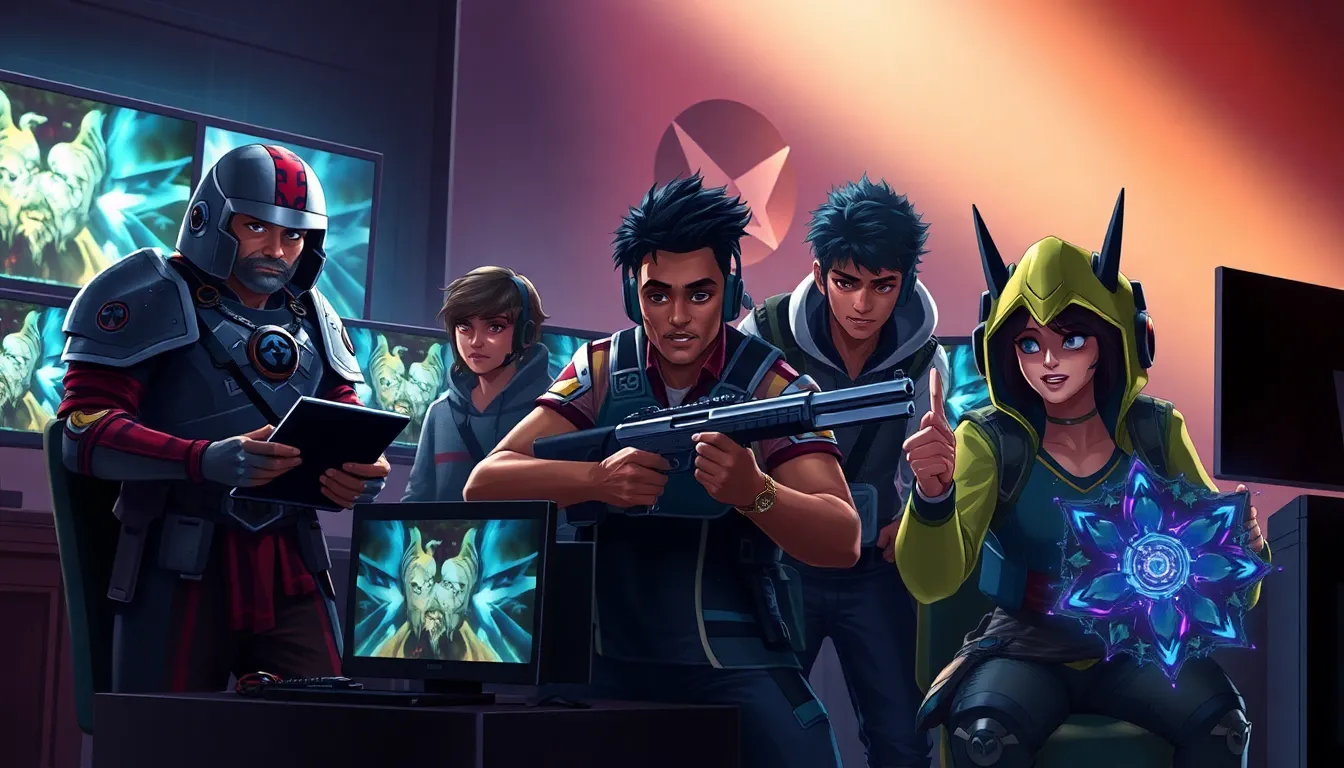Table of Contents
ToggleIn the fast-paced world of League of Legends, mastering a champion is just the beginning. Understanding the intricacies of each role can make all the difference between victory and defeat. Whether you’re a seasoned player or just starting out, knowing how to effectively navigate your chosen role is crucial for team success.
Role guides offer invaluable insights into the unique responsibilities and strategies associated with each position on the Rift. From the strategic mind of a jungler to the sharpshooting precision of an ADC, each role has its own set of skills and tactics that can elevate gameplay. With the right guidance, players can enhance their performance, improve teamwork, and ultimately climb the ranks.
Overview of LoL Role Guides
LoL role guides provide essential insights into the distinct functions and strategies of each position within the game. They highlight the responsibilities players hold, from positioning to map awareness. These resources break down the nuances of roles, helping players understand how to maximize their impact.
Key Roles in League of Legends
- Top Lane
- Focuses on durability and sustained damage.
- Engages in split-pushing and team fight initiation.
- Requires knowledge of matchups and wave management.
- Jungle
- Primarily responsible for providing vision and map control.
- Assists lanes through ganking and counter-ganking.
- Needs to optimize pathing and timing for objectives.
- Mid Lane
- Acts as the primary burst damage dealer and mage control.
- Often roams to other lanes to create advantages.
- Requires skill in managing cooldowns and trading.
- ADC (Attack Damage Carry)
- Key damage source in the late game.
- Rely on positioning and kiting effectively during fights.
- Must develop synergy with the support for lane dominance.
- Support
- Enhances the team’s utility through crowd control and healing.
- Provides vision and protects carries, especially ADCs.
- Focuses on map awareness and communication with teammates.
LoL role guides streamline the learning curve, enabling players to quicken their adaptation to each position. They facilitate deeper comprehension of champions’ strengths and weaknesses in different roles, ultimately leading to more effective teamwork and improved individual performance. Utilizing these guides, players can refine their skills and enhance their strategic gameplay in a competitive environment.
Understanding Roles in League of Legends

Mastering roles in League of Legends represents a fundamental aspect of achieving success. Each role has distinct responsibilities, which players must understand to improve their gameplay and teamwork.
The Importance of Each Role
Each role plays a critical part in the overall dynamics of a team.
- Top Lane: Focuses on absorbing damage and controlling waves. Champions in this role often tank or bruiser types, providing durability for team fights.
- Jungle: Responsible for map control and vision. Junglers create opportunities through ganks, influencing lanes, and securing objectives.
- Mid Lane: Typically serves as a burst damage dealer. Mid Laners often excel at damaging enemies quickly and navigating skirmishes with high mobility.
- ADC (Attack Damage Carry): Crucial for late-game damage output. ADCs rely on farming efficiently and positioning strategically during team fights to maximize damage.
- Support: Enhances team utility and communication. Supports provide vision, crowd control, and healing or shielding, allowing carries to thrive.
Understanding these roles allows players to strategize effectively, fostering a cohesive gameplay experience.
Common Misconceptions About Roles
Several misconceptions surround roles in League of Legends that can hinder player development.
- Every Role Can Solo Carry: While certain roles like ADCs or Mid Laners can lead, teamwork remains vital across all roles.
- Support Players Are Passive: Supports often initiate fights and frequently influence the game’s pace through vision control.
- Top Lane Is Isolated: While Top Lane appears independent, it requires frequent attention from the jungler to maintain pressure.
- Jungle Role Is Easy: The jungle requires extensive map awareness, strategic planning, and adaptability to shifting circumstances.
- Mid Lane Dominance Guarantees Victory: Mid Lane influence is significant, yet successful execution relies on the entire team’s performance.
Correcting these misconceptions can enhance a player’s effectiveness and improve overall team synergy.
Detailed Role Guides
Mastering each role in League of Legends enhances gameplay and teamwork, leading to higher success rates. Below are specific guides for the main roles, outlining their responsibilities and strategies.
Top Lane Guide
Top Lane champions generally excel in durability and split-pushing. They act as frontline fighters who absorb damage and engage enemies. Key responsibilities include:
- Wave Management: Controlling minion waves is vital for denying the enemy farm and ensuring better positioning during skirmishes.
- Map Awareness: Keeping an eye on the mini-map allows for timely teleports and engages, providing pressure across the map.
- Team Fights: Tanky champions often initiate fights, absorbing damage for teammates and disrupting enemy formations.
Examples of effective Top Lane champions include Malphite, Ornn, and Fiora.
Jungle Guide
Jungle champions focus on map control and providing vision. They play a critical role in securing objectives and supporting teammates. Essential tasks include:
- Gank Timing: Executing successful ganks requires awareness of enemy positions and effective use of crowd control.
- Objective Control: Securing buffs, Dragons, and Baron is crucial for team strength and momentum.
- Vision Control: Placing wards in strategic locations aids in tracking enemy movements and securing objectives safely.
Notable Jungle champions include Lee Sin, Kha’Zix, and Elise.
Mid Lane Guide
Mid Lane champions serve as primary damage dealers and playmakers. Their role centers around burst damage and map influence. Key aspects include:
- Roaming: Effectively roaming to other lanes supports team objectives and creates advantages.
- Burst Damage: Utilizing high-damage abilities can eliminate threats quickly, enabling successful team fights.
- Control Mages: Champions like Syndra or Orianna control the flow of fights with crowd control and area-of-effect spells.
Champions such as Zed, Ahri, and Viktor thrive in this role.
ADC Guide
AD Carry champions prioritize late-game damage output, positioning, and kiting. They significantly influence team fights and objectives. Main responsibilities involve:
- Positioning: Staying behind the front line during engagements is critical to avoid unnecessary deaths and maximize damage.
- Farming: Efficiently farming minions increases gold income, directly impacting damage potential.
- Objective Damage: Targeting turrets, Dragons, and Baron can shift the game’s momentum.
Effective ADC champions include Jhin, Kai’Sa, and Miss Fortune.
Support Guide
Support champions enhance team synergy, providing utility and crowd control. Their influence spans throughout engagements and map awareness. Key functions involve:
- Vision Control: Placing and sweeping wards help maintain vision superiority, crucial for objective control.
- Engagement: Initiating fights or peeling for carries requires strategic use of crowd control abilities.
- Resource Management: Supporting carries in terms of items and health can help secure victories in late-game scenarios.
Champion choices for Support roles include Lulu, Thresh, and Nautilus.
Tips for Mastering Your Role
- Focus on Map Awareness: Maintain constant focus on the minimap. Awareness of enemy movements and objective status aids in making informed decisions.
- Communicate Effectively: Use pings and chat for timely communication. Coordinate with teammates to enable successful strategies and surprise attacks.
- Practice Last Hitting: Refine the skill of last hitting minions. Consistent gold income boosts item acquisition, enhancing overall performance.
- Understand Champion Matchups: Know the strengths and weaknesses of your champion against opponents. This knowledge guides gameplay and decision-making.
- Optimize Item Builds: Adapt item purchases based on match progression. Flexibility in item builds counters enemy compositions and maximizes effectiveness.
- Warding Strategically: Place wards in key areas to maintain vision control. Effective warding prevents ambushes and provides crucial information.
- Learn from Reviews: Analyze gameplay recordings to identify mistakes. Reviewing matches enhances understanding of positioning and decision-making.
- Refine Mechanics: Practice champion abilities and combos in custom games. Improving mechanics significantly affects in-game success.
- Master Objectives: Prioritize securing objectives like dragons and barons. Objectives provide team advantages crucial for victory.
- Adapt Playstyle: Adjust playstyle based on team composition and game state. Adaptability improves synergy and team collaboration during matches.
Mastering the intricacies of each role in League of Legends is vital for any player aiming to climb the ranks. By utilizing role guides, players can grasp the unique responsibilities tied to positions like Top Lane, Jungle, Mid Lane, ADC, and Support. This knowledge not only sharpens individual gameplay but also enhances overall team synergy.
Understanding common misconceptions about roles can further boost a player’s effectiveness. Emphasizing teamwork and recognizing the active contributions of all roles fosters a more cohesive gaming experience. With practical tips and a clear grasp of strategies, players can adapt and thrive in the competitive landscape of League of Legends. Embracing these insights leads to improved performance and a more enjoyable gaming journey.





